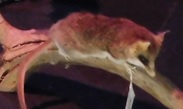Superregnum: Eukaryota
Regnum: Animalia
Subregnum: Eumetazoa
Cladus: Bilateria
Cladus: Nephrozoa
Superphylum: Deuterostomia
Phylum: Chordata
Subphylum: Vertebrata
Infraphylum: Gnathostomata
Superclassis: Tetrapoda
Cladus: Reptiliomorpha
Cladus: Amniota
Cladus: Synapsida
Cladus: Eupelycosauria
Cladus: Sphenacodontia
Cladus: Sphenacodontoidea
Cladus: Therapsida
Cladus: Theriodontia
Cladus: Cynodontia
Cladus: Mammaliaformes
Classis: Mammalia
Subclassis: Trechnotheria
Infraclassis: Zatheria
Supercohort: Theria
Cohort: Metatheria
Cohort: Marsupialia
Ordo: Diprotodontia
Subordo: Phalangeriformes
Superfamilia: Phalangeroidea
Familia: Burramyidae
Genus: Cercartetus
Species: Cercartetus caudatus
Subspecies: C. c. caudatus – C. c. macrura
Name
Cercartetus caudatus (Milne-Edwards, 1877)
Type locality: Indonesia, Irian Jaya, Vogelkop, Manokwari Div, Arfak Mtns.
Vernacular names
References
Cercartetus caudatus in Mammal Species of the World.
Wilson, Don E. & Reeder, DeeAnn M. (Editors) 2005. Mammal Species of the World – A Taxonomic and Geographic Reference. Third edition. ISBN 0-8018-8221-4.
C. R. Acad. Sci. Paris 85: 1079.
Wilson, D.E. & Reeder, D.M. (eds.) 2005. Mammal Species of the World: a taxonomic and geographic reference. 3rd edition. The Johns Hopkins University Press: Baltimore. 2 volumes. 2142 pp. ISBN 978-0-8018-8221-0. Reference page.
The long-tailed pygmy possum (Cercartetus caudatus) is a diprotodont marsupial found in the rainforests of northern Australia and New Guinea (Western New Guinea (Indonesia) and Papua New Guinea). Living at altitudes of above 1,500 m, it eats insects and nectar, and may eat pollen in place of insects in the wild.
It is known as sumsum in the Kalam language of Papua New Guinea.[3]
Description
The long-tailed pygmy possum has large eyes, mouse/rodent-like ears, a pouch that opens anteriorly, and a tail that is about one and a half times as long as the body, giving the possum its name.
Behavior
Not much is known of this possum's behaviour, but what is known is that this species is both nocturnal and arboreal. In cold weather, it becomes torpid and looks and feels dead, but wakes at night. Not much is known on the origin of this torpor.
Life cycle
This species breeds twice a year. Females have one to four young born around January and February and sometimes a second litter from late August to early September. The young leave the nest when they are 45 days old.
They only grow up to 10 cm (3.9 in).
References
Groves, C. P. (2005). Wilson, D. E.; Reeder, D. M. (eds.). Mammal Species of the World: A Taxonomic and Geographic Reference (3rd ed.). Baltimore: Johns Hopkins University Press. p. 44. ISBN 0-801-88221-4. OCLC 62265494.
Aplin, K.; Dickman, C.; Salas, L.; Burnett, S.; Winter, J. (2016). "Cercartetus caudatus". IUCN Red List of Threatened Species. 2016: e.T4192A21963339. doi:10.2305/IUCN.UK.2016-2.RLTS.T4192A21963339.en. Retrieved 12 November 2021.
Pawley, Andrew and Ralph Bulmer. 2011. A Dictionary of Kalam with Ethnographic Notes. Canberra. Pacific Linguistics.
Retrieved from "http://en.wikipedia.org/"
All text is available under the terms of the GNU Free Documentation License


